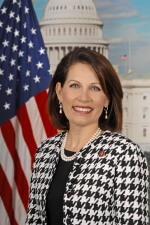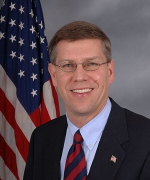Are Bachmann, Kline, and Paulsen ‘Too’ Conservative for Their Congressional Districts?
Difference between Kline’s conservative vote ranking and his district’s Partisan Voting Index ranking is the 2nd largest among all House Republicans; Bachmann 14th largest, Paulsen 27th

But while Bachmann is being targeted partially because Democrats believe she can be beat by their well-financed candidate, the Congresswoman’s seat is being pursued with such gusto by Democrats across Minnesota and the nation in no small part because of her outspoken, very conservative political ideology.
Despite the passion with which Democrats aim to unseat Bachmann, D.C. analysts call Bachmann the favorite to win a third term this November.
First, because Bachmann survived back-to-back victories during the Democratic tsunami years of 2006 and 2008, she is considered a favorite to win again during an election cycle in which most analysts believe there will be a Republican pullback, at least nationally.
‘Survived’ may indeed be the operative word.
For Representative Bachmann was reelected with the narrowest victory margin of any Republican incumbent in 2008, and, at 3.0 points, Bachmann also had the 5th narrowest margin of victory of the 178 GOPers elected into office that November.
Secondly, the Congresswoman’s campaign fundraising prowess is unmatched and has shattered records in the Gopher State. Minnesota Democrats may be cowering in anticipation of what Bachmann’s Q2 2010 numbers will look like next month – numbers that will include her high profile fundraiser with Sarah Palin in April.
But it is the third reason frequently given by those who prognosticate success for Bachmann in 2010 that is perhaps the least persuasive: that Bachmann will win because Minnesota’s 6th Congressional District is the most conservative and Republican-leaning district in the Gopher State.
It is true, of course, that CD6 has the largest Republican tilt in Minnesota. The Cook Political Report Partisan Voting Index (PVI) for the 111th Congress gives the 6th CD a 7-point Republican edge.
(The PVI value in MN-06 means that in the 2004 and 2008 presidential elections, the district performed an average of seven points more Republican than the nation did as a whole. The next closest district in Minnesota was DFLer Collin Peterson’s 7th CD, at +5 Republican).
But what is absent in this shorthand explanation for Bachmann’s favorable reelection odds is any comparative measurement between the extent of the ideological and partisan tilt of her district and the extent of the ideological and partisan tilt of Bachmann herself.
Comparing ideological and partisan measures is a tricky business – the two variables are not synonymous, though they are highly correlated.
The reason they should not be equated with one another is that, for example, a district with a low PVI tilt towards the GOP could theoretically still be a very conservative district, if that district is composed of a significant number of conservative independents and Democrats who sometimes vote Democratic in presidential elections.
But ideology and partisanship are not apples and oranges either, and what can be the basis for comparison are the rankings of members of Congress on both of these dimensions – relative to one another.
Smart Politics therefore conducted an analysis of these two variables – the ideological tilt of U.S. Representative voting records as measured by National Journal’s 2009 composite rankings and the Partisan Voting Index of each Representative’s congressional district, with an eye on how Bachmann’s rankings for each compare to her other 175+ Republican colleagues in the U.S. House.
The analysis found that the difference between Bachmann’s ideological ranking and her district’s partisan ranking was among the Top 15 largest among GOPers in the U.S. House.
The Republican tilt for Minnesota’s 6th Congressional District of +7 points makes it only the 142nd most Republican district in the country. Representative Bachmann, meanwhile, tallied the 28th most conservative score in National Journal’s 2009 vote rankings, or a district partisan vote/Representative ideology ranking differential of +114.
In short: Bachmann is more conservative than 84 percent of her colleagues, but her district tilts Republican more than only 20 percent of those of her fellow House GOPers.
It is this theme – that Bachmann is too conservative for her district that the Clark campaign will hope to hammer home throughout the summer and autumn.

Representative Kline scored the second largest differential among all Republican members in the U.S. House between these two rankings.
The Republican tilt for Kline’s 2nd CD of +4 points makes it only the 197th most Republican district in the country, with Kline receiving a composite ranking of the 32nd most conservative Representative in the U.S. House, for a district partisan vote/Representative ideology ranking differential of +165.
Kline therefore had a voting record in 2009 that was more conservative than 82 percent of his fellow Republicans, but represents a district that tilts more Republican than just 17 percent of GOP districts across the country.
Only Joseph Cao, the freshman Republican from the extremely Democratic 2nd District of Louisiana scores a larger difference. (Although Cao had the fourth least conservative ranking among House Republicans in 2009, his district has a +25-point Democratic tilt, making it the 402nd least Republican district in the country on the PVI index).
While no one has ever mistaken Congressman Kline for a liberal, or even a moderate, he does not endure even a fraction of the criticism from the left as Bachmann for what is essentially an equally conservative voting record, even though Kline represents a more Democratic district than the more outspoken and media-friendly Congresswoman from Stillwater.

Paulsen scored the 144th most conservative voting record in the House in 2009, while his district’s PVI ranking (even – no GOP or Democratic tilt) was only the 237th most Republican in the country, for a district partisan vote/Representative ideology ranking differential of +93, or the 27th highest in the GOP caucus.
Why Minnesota’s U.S. Representatives are conspicuously represented at the top of this list is a bit of a mystery. Only California had more Representatives scoring in the Top 30 (with five), though the Golden State has 19 Republicans in its U.S. House delegation.
Perhaps there is a new breed of Republicans rising to power in the Upper Midwest: Wisconsin’s GOP star Paul Ryan (#5) and Iowa’s Tom Latham (#11) and Steve King (#19) all cracked the Top 20 as well.
Congressional District Partisan Vote / Representative Ideology Ranking Differential (Top 50 GOPers)
|
Rank
|
Name
|
District
|
Ideology rank
|
PVI rank
|
Difference
|
|
1
|
Jospeh Cao
|
LA-02
|
175
|
402
|
+227
|
|
2
|
John Kline
|
MN-02
|
32
|
197
|
+165
|
|
3
|
Don Manzullo
|
IL-16
|
62
|
214
|
+152
|
|
4
|
David Dreier
|
CA-26
|
66
|
203
|
+137
|
|
5
|
Paul Ryan
|
WI-01
|
89
|
218
|
+129
|
|
6
|
Peter Roskam
|
IL-06
|
118
|
243
|
+125
|
|
7
|
Randy Forbes
|
VA-04
|
66
|
191
|
+125
|
|
8
|
Pete Sessions
|
TX-32
|
12
|
134
|
+122
|
|
9
|
Michael Castle
|
DE-AL
|
183
|
303
|
+120
|
|
9
|
Mark Kirk
|
IL-10
|
174
|
294
|
+120
|
|
11
|
Tom Latham
|
IA-04
|
122
|
241
|
+119
|
|
12
|
John Shadegg
|
AZ-03
|
1
|
119
|
+118
|
|
13
|
Jim Gerlach
|
PA-06
|
159
|
274
|
+115
|
|
14
|
Michele Bachmann
|
MN-06
|
28
|
142
|
+114
|
|
15
|
Mike Rogers
|
MI-08
|
111
|
224
|
+113
|
|
16
|
Pat Tiberi
|
OH-12
|
132
|
244
|
+112
|
|
17
|
Elton Gallegly
|
CA-24
|
87
|
198
|
+111
|
|
18
|
George Radanovich
|
CA-19
|
16
|
126
|
+110
|
|
19
|
Steve King
|
IA-05
|
9
|
118
|
+109
|
|
20
|
Bill Posey
|
FL-15
|
62
|
170
|
+108
|
|
21
|
Todd Akin
|
MO-02
|
11
|
117
|
+106
|
|
22
|
Brian Bilbray
|
CA-50
|
101
|
204
|
+103
|
|
22
|
Bill Young
|
FL-10
|
128
|
231
|
+103
|
|
24
|
Tom McClintock
|
CA-04
|
9
|
108
|
+99
|
|
25
|
Mike Pence
|
IN-06
|
8
|
106
|
+98
|
|
26
|
Joe Pitts
|
PA-16
|
38
|
132
|
+94
|
|
27
|
Erik Paulsen
|
MN-03
|
144
|
237
|
+93
|
|
28
|
Bob Latta
|
OH-05
|
27
|
120
|
+93
|
|
29
|
John Mica
|
FL-07
|
58
|
149
|
+91
|
|
29
|
Thaddeus McCotter
|
MI-11
|
147
|
238
|
+91
|
|
29
|
Charlie Dent
|
PA-15
|
166
|
257
|
+91
|
|
32
|
Scott Garrett
|
NJ-05
|
55
|
145
|
+90
|
|
32
|
Dave Reichert
|
WA-08
|
178
|
268
|
+90
|
|
34
|
Frank LoBiondo
|
NJ-02
|
159
|
245
|
+86
|
|
35
|
Eric Cantor
|
VA-07
|
37
|
122
|
+85
|
|
36
|
Frank Wolf
|
VA-10
|
131
|
215
|
+84
|
|
37
|
Pete Olson
|
TX-22
|
1
|
84
|
+83
|
|
38
|
Ed Royce
|
CA-40
|
52
|
133
|
+81
|
|
39
|
Trent Franks
|
AZ-02
|
1
|
80
|
+79
|
|
39
|
Dean Heller
|
NV-02
|
99
|
178
|
+79
|
|
41
|
Dan Lungren
|
CA-03
|
98
|
175
|
+77
|
|
42
|
Tom Rooney
|
FL-16
|
114
|
188
|
+74
|
|
43
|
Buck McKeon
|
CA-25
|
94
|
166
|
+72
|
|
44
|
John Campbell
|
CA-48
|
105
|
173
|
+68
|
|
45
|
Kenny Marchant
|
TX-24
|
26
|
93
|
+67
|
|
46
|
Wally Herger
|
CA-02
|
31
|
97
|
+66
|
|
46
|
Ken Calvert
|
CA-44
|
96
|
162
|
+66
|
|
46
|
Mary Bono Mack
|
CA-45
|
135
|
201
|
+66
|
|
49
|
Duncan Hunter
|
CA-52
|
48
|
114
|
+66
|
|
50
|
Dana Rohrabacher
|
CA-46
|
110
|
174
|
+64
|
|
50
|
Fred Upton
|
MI-06
|
172
|
236
|
+64
|
|
50
|
Sue Myrick
|
NC-09
|
34
|
98
|
+64
|
Ideology ranking from National Journal’s 2009 U.S. House composite conservative ratings. Partisan Voting Index from Cook Political Report. Table compiled by Smart Politics.
Follow Smart Politics on Twitter.
